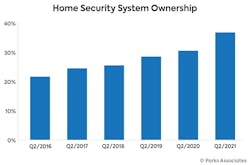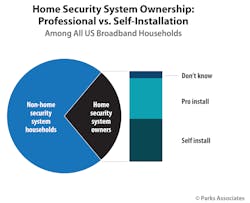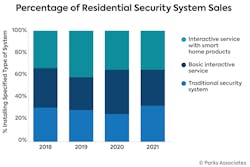Related to
Latest from WEB EXCLUSIVES
The Role of Video Analytics, AI, and ML
Traditional residential security players continue to integrate advanced home security technologies, especially around AI and video analytics, to create new service offerings, address new customer segments, and integrate with Google and Amazon.
Consumer choice regarding installation, device bundles, and monitoring services is a driving force for both professional and DIY solutions. Broadening consumer adoption of smart home products through retail, traditional home security system providers, Communication Service Providers (CSPs), and Internet Service Providers (ISPs) creates an onboarding ramp to the development of new professional services–or added revenue to existing services. Currently, 36% of Internet households have a home security system as shown in Figure 1.
It’s All About Control: AI and Unified Apps
Consumers have a variety of options for home control: self-installed DIY systems like SmartThings or Wink; pro-installed systems offered by security services like ADT Pulse or Brinks, with Alarm.com technology; or custom whole-home systems like Control4 or Crestron. Consumers can also create smart home control through individual devices with cloud-to-cloud integrations that do not rely on traditional hardware controllers, like Amazon Alexa, Google Home, Works with Nest, and various API integrations. As smart home control continues to evolve, consumers can anticipate that new capabilities will emerge (See Figure 2.):
- Predictive analytics and machine learning could help create better experiences in the smart home by learning family habits, household patterns, and individual preferences–and using that intelligence to create automation sequences.
- Machine learning will be able to adjust personal settings as the occupant’s behavior changes over time or other contextual factors come into play, such as time of year, day of the week, presence of others in the home, or weather conditions.
- Push notifications–information-based suggestions–could lead to nudges (action-based suggestions derived from previous behaviors), leading to true automation after the user has affirmed certain courses of action or preferences.
- One unified app could offer critical consumer control, with 86% of smart home device owners wanting a single unified app to control all smart home devices.
Sales of networked cameras, video doorbells and smart speakers/smart displays will reach 250 million units in 2024. (See Figure 3.)
Video analytics play a significant role in residential security video surveillance technology and require greater bandwidth, lower latency, and 24/7 connectivity. The induction of video analytics in modern video surveillance solutions can help detect and deter potential criminal activity, reduce false alarms, and accommodate touchless solutions. There is an excellent opportunity for security providers to build on their core offerings by extending security all the way from inside the home to the perimeter of a property.
A key benefit of video analytics in the security space is providing a more personalized user experience with more intelligent alerts. False alerts caused by simple motion detection can frustrate users by generating a high volume of notifications due to harmless triggers, such as wind or shadows, leading users to disable or ignore alerts. In fact, 25% of home security system owners or purchase intenders in US broadband households ranked video verification to reduce false alerts and expedite first responder dispatch among their top three desired security system features, a slight increase from 23% in 2020. Thankfully, advanced AI applications deployed for commercial security services, including video analytics and machine learning, are trickling down to residential customers and helping to address these frustrations.
Video analytics play a significant role in residential security video surveillance technology and require greater bandwidth, lower latency, and 24/7 connectivity. The induction of video analytics in modern video surveillance solutions can help detect and deter potential criminal activity, reduce false alarms, and accommodate touchless solutions.
On average, security system owners report experiencing more than three false alarms in a year, commonly caused by pets triggering a motion sensor, a smoke detector activating, and low or dead batteries in the system or an attached device. In fact, 48% of US security system owners at home agree that their home security system triggers too many false alarms, and 39% strongly agree.
False alarms can also result in fees for security owners ranging from $25-250 per incident, and responses to false alarms have been estimated to cost local police departments billions annually. Both system owners and monitoring stations can benefit from video analytics by using the provided visual information to aid their assessment of whether the alarm requires an emergency response–reducing response for false alarms and promoting more rapid response for verified alarms.
ABOUT THE AUTHOR
Elizabeth Parks is President and CMO at Parks Associates, a woman- and family-owned consumer technology market research and consulting firm. She has more than 23 years of experience in integrated strategic communications. For more information, please email: [email protected] or visit www.ParksAssociates.com. You can also follow her on Twitter: @elizparks.
This excerpt is adapted from Parks Associates new white paper, Value Beyond Home Security: Expanding Product Ecosystems, published in partnership with Alarm.com. This whitepaper addresses the expansion of professional services beyond home security–driven by the growth of connected devices, new technology, and unified offerings from professional service providers and DIY solutions. Download the full paper at: http://www.parksassociates.com/whitepapers/beyondsecurity-wp2021-ISE
Company Social Media Handles:
LinkedIn: @ParksAssociates https://www.linkedin.com/company/parksassociates/
Twitter: @ParksAssociates https://twitter.com/ParksAssociates
Instagram: @ParksAssociates https://www.instagram.com/parksassociates/?hl=en
Facebook: @ParksAssociates https://www.facebook.com/ParksAssociates/
YouTube: @ParksAssociates https://www.youtube.com/user/ParksAssociates
Podcast: https://podcasts.apple.com/us/podcast/the-connected-consumer/id1572500283
Elizabeth Parks | President and CMO, Parks Associates
Elizabeth Parks is the President and CMO of Parks Associates. She has more than 24 years of experience overseeing research topics and coverage areas for the company and directing the integrated strategic communications plan for Parks Associates, including advertising, public relations, and marketing. For more information, please email: [email protected] or visit www.ParksAssociates.com. You can also follow her on Twitter: @elizparks.
Company Social Media Handles:
LinkedIn: @ParksAssociates https://www.linkedin.com/company/parksassociates/
Twitter: @ParksAssociates https://twitter.com/ParksAssociates
Instagram: @ParksAssociates https://www.instagram.com/parksassociates/?hl=en
Facebook: @ParksAssociates https://www.facebook.com/ParksAssociates/
YouTube: @ParksAssociates https://www.youtube.com/user/ParksAssociates
Podcast: https://podcasts.apple.com/us/podcast/the-connected-consumer/id1572500283










